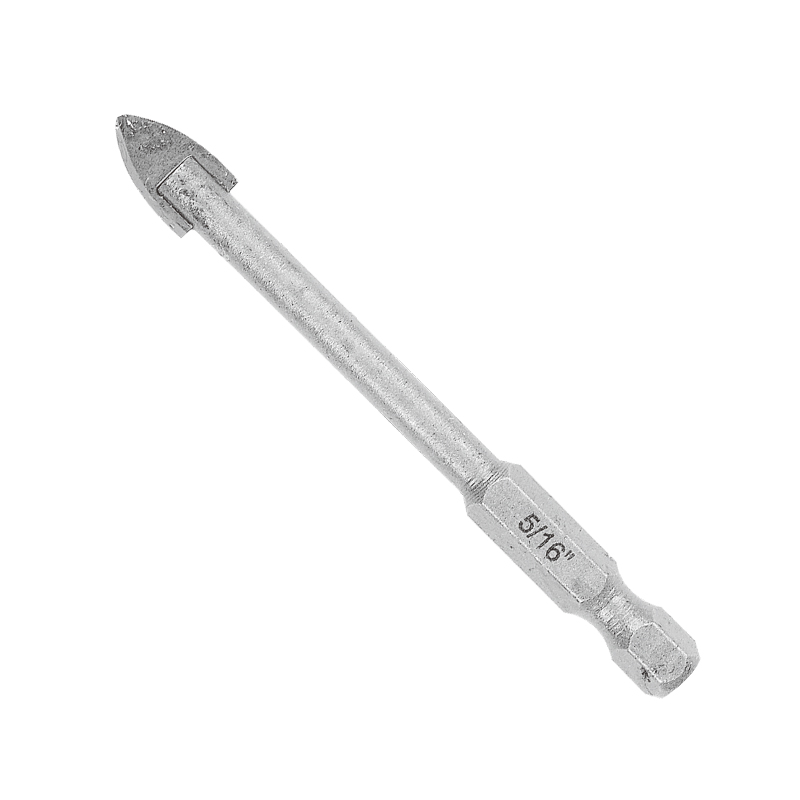2025-06-25
Choosing the right drill bit is essential for achieving suitable results and avoiding damage when working with various materials. Glass drilling, in particular, requires special considerations because of the fragile and brittle nature of glass. A Glass Drill Bit differs significantly from ordinary drill bits used for wood, metal, or plastic. This article explores these differences in detail to help users understand why a Glass Drill Bit is necessary for certain applications and how it differs from regular bits.

The major difference lies in the materials used to manufacture the cutting tips. Glass Drill Bits are often made from tungsten carbide or feature diamond grit coatings. These materials provide exceptional hardness and abrasion resistance, which are critical for penetrating the smooth, brittle surface of glass without causing cracks or chipping. Regular drill bits, such as those made from high-speed steel (HSS), cobalt, or carbon steel, lack this extreme hardness. They are optimized for softer materials like wood, plastics, or metals, but are prone to dulling quickly or damaging glass surfaces if used improperly.
Tip design also sets the Glass Drill Bit apart. It typically has a spear-shaped or pointed tip engineered to apply focused pressure on a small surface area, enabling the bit to score the glass cleanly before drilling deeper. This shape helps prevent slipping and reduces surface damage. Ordinary drill bits often have a conical or twisted shape designed to cut or scrape through softer materials by removing material in a helical motion. These shapes are ineffective on glass, as they tend to wander on the smooth surface and cause uneven pressure that causes cracking.
The flute design—the grooves along the drill bit that remove debris—is another key distinction. Glass Drill Bits have flutes specifically shaped to evacuate fine glass dust and chips efficiently. Removing this debris quickly is crucial because accumulation increases friction and heat, which can cause thermal stress fractures in glass. Regular drill bits have flutes optimized for chips produced from wood, metal, or plastic, which are typically larger and less abrasive. Using a normal bit on glass can cause clogging and overheating, making cracks more likely.
Drilling technique and operational parameters differ significantly between the two types of bits. Glass drilling requires slower rotational speeds combined with light, steady pressure. This controlled approach reduces heat buildup and mechanical stress on the glass. Additionally, continuous cooling—usually by water—is necessary to dissipate heat and wash away debris, further protecting the glass from thermal cracking. In contrast, regular drill bits are often used at higher speeds and greater pressure, suitable for tougher or more ductile materials. Applying these aggressive methods to glass with a normal bit usually results in damage.
Durability and maintenance considerations also differ. Because glass is a hard and brittle material, Glass Drill Bits experience significant wear if used without proper cooling or technique. They require careful handling to maintain sharpness and extend lifespan. Regular bits generally have longer durability on their intended materials and do not require as much specialized care.
Finally, the application scope is an important factor. Glass Drill Bits are specialized tools primarily intended for drilling holes in glass, ceramic tiles, and sometimes other brittle materials like porcelain. Regular drill bits have a broader application range across wood, metal, plastic, and composites, but are unsuitable for glass without risking damage.
In conclusion, the Glass Drill Bit is specifically engineered with harder materials, specialized tip geometry, optimized flute design, and usage techniques tailored for fragile glass surfaces. These differences make it indispensable for safe, efficient, and clean drilling in glass, where ordinary drill bits would fail or cause damage. Understanding these distinctions ensures users select the appropriate tool, improving drilling outcomes and preserving both the glass and the drill bit’s longevity.